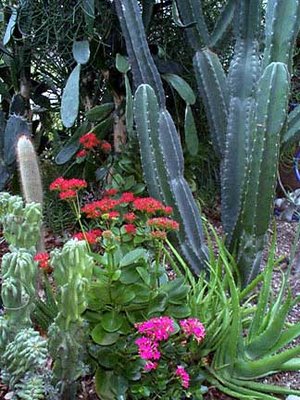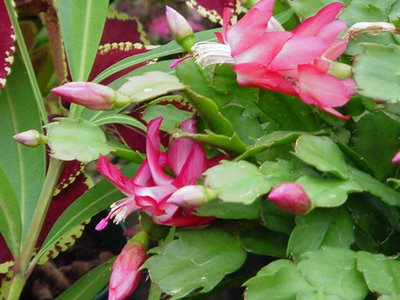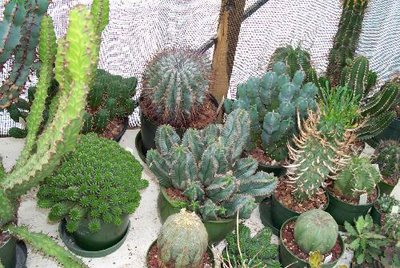Cacti And Succulent Plants

Picture of Cacti and Succulent Garden
Cacti are succulent to varying degrees and belong to one family, the Cactaceae, whereas succulents can belong to many different plant families. They all have in common the ability to store water in their tissues in order to survive periods of drought, and this makes them ideal plants for the busy or forgetful person; many can survive days or even weeks of dryness.

Picture of rhipsalis chloroptera
Cacti in particular can be divided into desert and jungle types; the latter live on trees as epiphytes, often in association with orchids, in tropical rain forests. Epiphytes use trees for support only; they are not parasites. Such cacti are represented by the epiphyllums, rhipsalis species (picture above), the Christmas cactus(picture below), and similar plants.

Picture of Christmas Cactus (Schlumbergera bridgesi) - Christmas Cactus is a favorite holiday seasonhouse plant, but one which needs careful attention to details if it is to live and flower again the next year. It is closely related to Easter Cactus (Schlumbergera gaertneri) and Thanksgiving Cactus (Schlumbergera truncatus), all with fleshy, flattened, segmented joints and showy flowers ranging in color from white through pink, red and purple. These are cacti which in nature live in the crotches of jungle trees, and benefit from light, porous soil mixed with leafmold and sand.
Often any thick-leaved or spiny plant is called a cactus, sometimes incorrectly. A unique feature of cacti is the "areole", a small, pin- cushion-likek structure arranged in numbers over the stems, from wh
 ich any spines or hairs grow. All cacti have areoles but they are not always easy to see. The cactus flower is also characteristic and is often large and beautiful.
ich any spines or hairs grow. All cacti have areoles but they are not always easy to see. The cactus flower is also characteristic and is often large and beautiful. Many cacti bloom annually; but a few can never become large enough in an average amateur collection to do so. Cacti are 'stem succulents', that is, water is stored in greatly thickened stems and, apart form the exception mentioned earlier (the pereskias, picture on the left) and a few other rarities, they have no real leaves.
Other succulent, coming as they do from many different families, have flowers as diverse as the families themselves. They have no areoles; any spines resemble rose thorns. Some African euphorbias are virtually leafless, and with their ribbed, thorny, succulent stems they closely resemble cacti.

Picture of euphorbia
Cacti come from the American continent and those found elsewhere in the world have been introduced at some time in the past. Many other succulents are native to Africa.







0 Comments:
Post a Comment
<< Home